3.2: Determinación del diámetro del árbol
- Page ID
- 52664
\( \newcommand{\vecs}[1]{\overset { \scriptstyle \rightharpoonup} {\mathbf{#1}} } \)
\( \newcommand{\vecd}[1]{\overset{-\!-\!\rightharpoonup}{\vphantom{a}\smash {#1}}} \)
\( \newcommand{\id}{\mathrm{id}}\) \( \newcommand{\Span}{\mathrm{span}}\)
( \newcommand{\kernel}{\mathrm{null}\,}\) \( \newcommand{\range}{\mathrm{range}\,}\)
\( \newcommand{\RealPart}{\mathrm{Re}}\) \( \newcommand{\ImaginaryPart}{\mathrm{Im}}\)
\( \newcommand{\Argument}{\mathrm{Arg}}\) \( \newcommand{\norm}[1]{\| #1 \|}\)
\( \newcommand{\inner}[2]{\langle #1, #2 \rangle}\)
\( \newcommand{\Span}{\mathrm{span}}\)
\( \newcommand{\id}{\mathrm{id}}\)
\( \newcommand{\Span}{\mathrm{span}}\)
\( \newcommand{\kernel}{\mathrm{null}\,}\)
\( \newcommand{\range}{\mathrm{range}\,}\)
\( \newcommand{\RealPart}{\mathrm{Re}}\)
\( \newcommand{\ImaginaryPart}{\mathrm{Im}}\)
\( \newcommand{\Argument}{\mathrm{Arg}}\)
\( \newcommand{\norm}[1]{\| #1 \|}\)
\( \newcommand{\inner}[2]{\langle #1, #2 \rangle}\)
\( \newcommand{\Span}{\mathrm{span}}\) \( \newcommand{\AA}{\unicode[.8,0]{x212B}}\)
\( \newcommand{\vectorA}[1]{\vec{#1}} % arrow\)
\( \newcommand{\vectorAt}[1]{\vec{\text{#1}}} % arrow\)
\( \newcommand{\vectorB}[1]{\overset { \scriptstyle \rightharpoonup} {\mathbf{#1}} } \)
\( \newcommand{\vectorC}[1]{\textbf{#1}} \)
\( \newcommand{\vectorD}[1]{\overrightarrow{#1}} \)
\( \newcommand{\vectorDt}[1]{\overrightarrow{\text{#1}}} \)
\( \newcommand{\vectE}[1]{\overset{-\!-\!\rightharpoonup}{\vphantom{a}\smash{\mathbf {#1}}}} \)
\( \newcommand{\vecs}[1]{\overset { \scriptstyle \rightharpoonup} {\mathbf{#1}} } \)
\( \newcommand{\vecd}[1]{\overset{-\!-\!\rightharpoonup}{\vphantom{a}\smash {#1}}} \)
\(\newcommand{\avec}{\mathbf a}\) \(\newcommand{\bvec}{\mathbf b}\) \(\newcommand{\cvec}{\mathbf c}\) \(\newcommand{\dvec}{\mathbf d}\) \(\newcommand{\dtil}{\widetilde{\mathbf d}}\) \(\newcommand{\evec}{\mathbf e}\) \(\newcommand{\fvec}{\mathbf f}\) \(\newcommand{\nvec}{\mathbf n}\) \(\newcommand{\pvec}{\mathbf p}\) \(\newcommand{\qvec}{\mathbf q}\) \(\newcommand{\svec}{\mathbf s}\) \(\newcommand{\tvec}{\mathbf t}\) \(\newcommand{\uvec}{\mathbf u}\) \(\newcommand{\vvec}{\mathbf v}\) \(\newcommand{\wvec}{\mathbf w}\) \(\newcommand{\xvec}{\mathbf x}\) \(\newcommand{\yvec}{\mathbf y}\) \(\newcommand{\zvec}{\mathbf z}\) \(\newcommand{\rvec}{\mathbf r}\) \(\newcommand{\mvec}{\mathbf m}\) \(\newcommand{\zerovec}{\mathbf 0}\) \(\newcommand{\onevec}{\mathbf 1}\) \(\newcommand{\real}{\mathbb R}\) \(\newcommand{\twovec}[2]{\left[\begin{array}{r}#1 \\ #2 \end{array}\right]}\) \(\newcommand{\ctwovec}[2]{\left[\begin{array}{c}#1 \\ #2 \end{array}\right]}\) \(\newcommand{\threevec}[3]{\left[\begin{array}{r}#1 \\ #2 \\ #3 \end{array}\right]}\) \(\newcommand{\cthreevec}[3]{\left[\begin{array}{c}#1 \\ #2 \\ #3 \end{array}\right]}\) \(\newcommand{\fourvec}[4]{\left[\begin{array}{r}#1 \\ #2 \\ #3 \\ #4 \end{array}\right]}\) \(\newcommand{\cfourvec}[4]{\left[\begin{array}{c}#1 \\ #2 \\ #3 \\ #4 \end{array}\right]}\) \(\newcommand{\fivevec}[5]{\left[\begin{array}{r}#1 \\ #2 \\ #3 \\ #4 \\ #5 \\ \end{array}\right]}\) \(\newcommand{\cfivevec}[5]{\left[\begin{array}{c}#1 \\ #2 \\ #3 \\ #4 \\ #5 \\ \end{array}\right]}\) \(\newcommand{\mattwo}[4]{\left[\begin{array}{rr}#1 \amp #2 \\ #3 \amp #4 \\ \end{array}\right]}\) \(\newcommand{\laspan}[1]{\text{Span}\{#1\}}\) \(\newcommand{\bcal}{\cal B}\) \(\newcommand{\ccal}{\cal C}\) \(\newcommand{\scal}{\cal S}\) \(\newcommand{\wcal}{\cal W}\) \(\newcommand{\ecal}{\cal E}\) \(\newcommand{\coords}[2]{\left\{#1\right\}_{#2}}\) \(\newcommand{\gray}[1]{\color{gray}{#1}}\) \(\newcommand{\lgray}[1]{\color{lightgray}{#1}}\) \(\newcommand{\rank}{\operatorname{rank}}\) \(\newcommand{\row}{\text{Row}}\) \(\newcommand{\col}{\text{Col}}\) \(\renewcommand{\row}{\text{Row}}\) \(\newcommand{\nul}{\text{Nul}}\) \(\newcommand{\var}{\text{Var}}\) \(\newcommand{\corr}{\text{corr}}\) \(\newcommand{\len}[1]{\left|#1\right|}\) \(\newcommand{\bbar}{\overline{\bvec}}\) \(\newcommand{\bhat}{\widehat{\bvec}}\) \(\newcommand{\bperp}{\bvec^\perp}\) \(\newcommand{\xhat}{\widehat{\xvec}}\) \(\newcommand{\vhat}{\widehat{\vvec}}\) \(\newcommand{\uhat}{\widehat{\uvec}}\) \(\newcommand{\what}{\widehat{\wvec}}\) \(\newcommand{\Sighat}{\widehat{\Sigma}}\) \(\newcommand{\lt}{<}\) \(\newcommand{\gt}{>}\) \(\newcommand{\amp}{&}\) \(\definecolor{fillinmathshade}{gray}{0.9}\)3.2 Determinación del diámetro del árbol

Figura 3.2. Un árbol que muestra cómo los diámetros no son constantes a medida que uno se mueve hacia arriba por un árbol.
Los árboles no crecen como cilindros, sino que se estrechan hacia arriba, el diámetro del árbol se hace más pequeño a medida que uno se acerca a la parte superior del árbol. Los árboles también tienen oleaje a tope, un engrosamiento de la madera y corteza en la base del árbol para soportar la masa del árbol (Figura 3.2). El oleaje a tope puede crear un diámetro muy grande en árboles expuestos al fuerte viento, en pendientes pronunciadas y en rodales escasamente poblados. Así, cuando realmente piensas en tratar de obtener datos útiles de diámetro, la pregunta es, “¿en qué parte del árbol debo medirlo?”
Para que las mediciones del diámetro de los árboles sean significativas y fáciles de realizar, se han desarrollado una ubicación estándar y un protocolo. Los diámetros se miden fuera de la corteza al Diámetro a la Altura del Pecho (DBH), o 4½ pies sobre el suelo en el lado cuesta arriba del árbol (Figura 3.3). Esta ubicación está por encima de la mayoría de los glúteos, por encima de la mayor parte del cepillo, y se encuentra en una posición cómoda del brazo para la mayoría
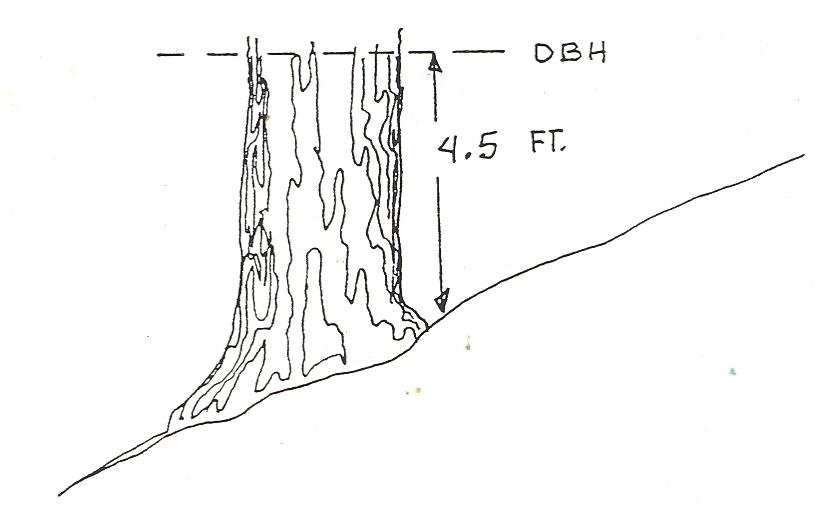
Figura 3.3. La ubicación estándar para medir el diámetro del árbol está en DBH, 4.5 pies sobre el suelo en el lado cuesta arriba del árbol. (De [FS] 1990.)
Para la mayoría de los árboles en el bosque, medir dbh es bastante sencillo. Sin embargo, abundan los árboles irregulares que requieren adaptaciones (Figuras 3.4 — 3.10). (Todas las ilustraciones de o adaptadas de [FS] 1990.)
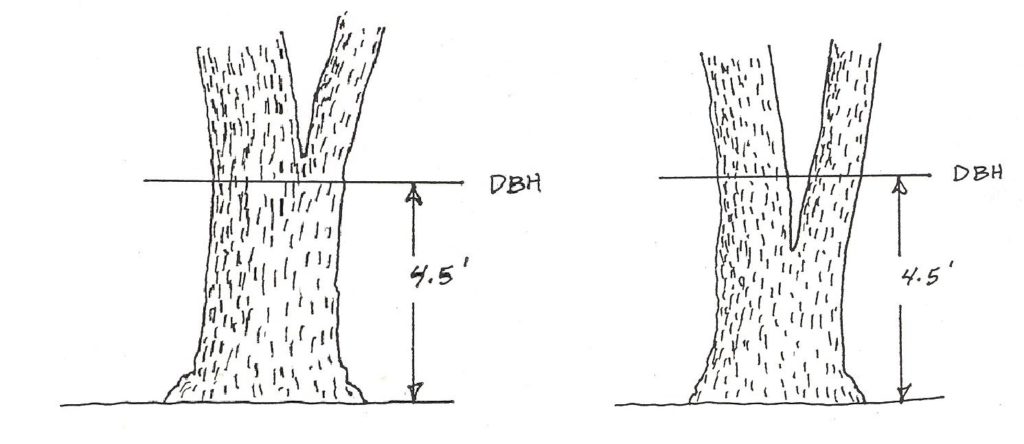
Figura 3.4. En árboles bifurcados, mida como un árbol si la bifurcación ocurre en o por encima de 4.5' (izquierda). Mida como dos árboles si la bifurcación ocurre por debajo de 4.5' (derecha).

Figura 3.5. Mida directamente encima de un bulto o verticilo de rama (izquierda). En árboles con oleaje a tope extenso, mida al menos 1½' por encima del oleaje trasero (derecha).

Figura 3.6. Para un burl o cancro grande, mida por encima de la deformidad y ajuste el diámetro ligeramente hacia abajo (izquierda), o tome dos medidas equidistantes de dbh por encima y por debajo de la deformidad, y use el promedio (derecha).
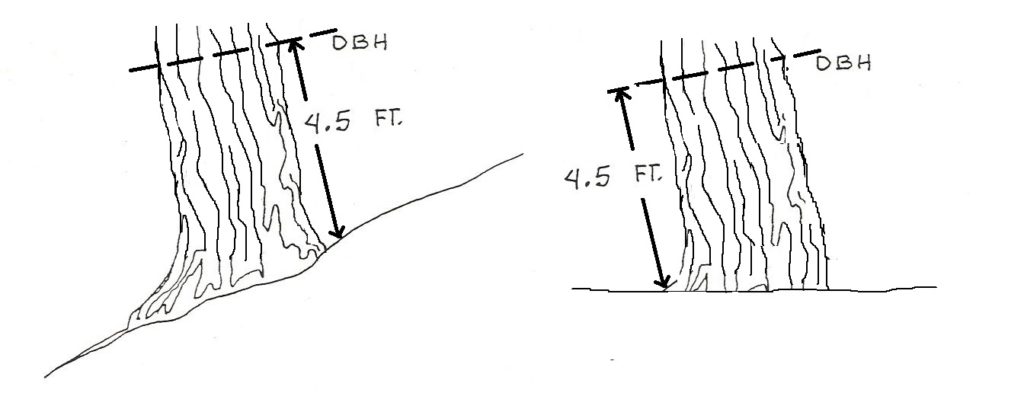
Figura 3.7. En árboles inclinados, la cinta se sostiene perpendicular al tronco del árbol, y se mide en el lado cuesta arriba del árbol si está en una pendiente (izquierda); en el lado corto de la inclinación si está en terreno plano (derecha).

Figura 3.8. En árboles con raíces sobre el suelo, medir a 4.5' por encima de la copa de la raíz (abajo).
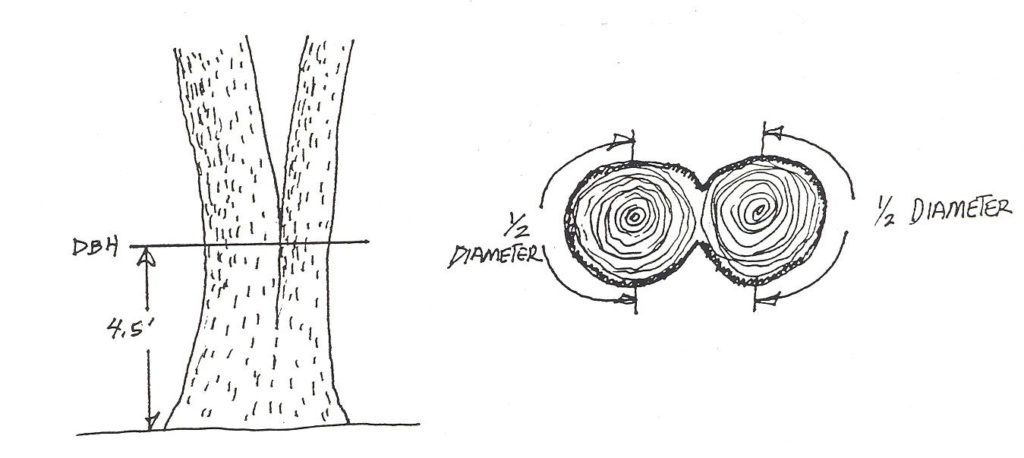
Figura 3.9. En árboles que han crecido juntos, cuente como dos árboles. Mida la mitad alrededor de cada uno y duplique la medición.
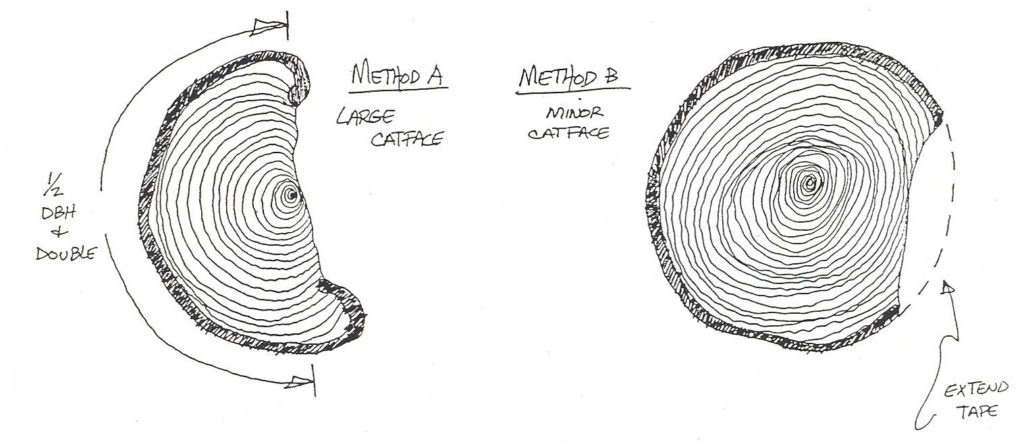
Figura 3.10. En árboles con cicatrices, trátelo como un árbol doble si es severo (izquierda), o reconstruya el diámetro si es leve (derecha).


